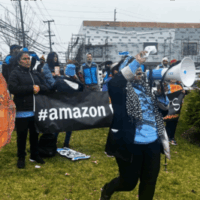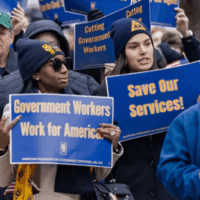Seattle just made history. On Dec. 15, and over the strong objections of industry behemoth Uber, the City Council unanimously passed an ordinance permitting for-hire drivers, including those that drive for Uber and Lyft as well as taxi drivers, to organize and collectively bargain with the companies they work for.
The Seattle ordinance is significant for two reasons: First, it’s a bold response to the prevailing business model in both taxi and the new app-based for-hire companies, which is to label their workers “independent contractors” rather than “employees.” Workers classified as independent contractors have none of the rights typically associated with employment in the United States: no minimum wage or overtime, no social safety net if they get injured or lose their jobs, and no protection from discrimination. (Both Uber and Lyft are facing class action litigation challenging this classification under California wage and hour law, and Uber has been sued in Washington state court as well). Most relevant to the new Seattle ordinance, independent contractors are excluded from the provisions of the National Labor Relations Act (NLRA), under which most traditional employees have the right to organize and collectively bargain.
But in Seattle, drivers have chosen to call the companies’ bluff: they’ve said that since the companies don’t call them “employees,” and have tried to deny them the federal right that employees have to organize, the city can step in and provide a local mechanism to protect their right as independent contractors to come together and negotiate over terms and conditions of their work. In fact, Seattle’s ordinance is arguably a simpler and more straightforward improvement over the federal law that the companies say doesn’t apply.
Second, Seattle has established that the arrogance and power of the on-demand economy can be overcome by the collective power of workers and their communities. Sure, Uber beat down an attempt by Mayor deBlasio to provide some reasonable regulation to its operations in New York City, but the well-connected and well-financed lobbyists of the on-demand economy lost this time.
The workers’ campaign featured leaders whose personal experiences told a story very different from what Uber peddles about drivers having the opportunity to “earn a better living on their own time and on their own terms.” Drivers like Takele Gobena said they make poverty wages and have no say in the policies that affect them. The drivers say they operate exclusively under Uber’s terms, including the unilateral lowering of its fares and deactivation of drivers from the platform when they speak up about these abuses.
Riders got into the act as well, letting the transportation network companies know that decent pay and a voice at work are values that consumers and workers have in common.
Predictably, and like the anti-union bosses of the “old” economy, Uber isn’t expected to allow its workers to organize without a fight. It is involved in litigation across the country, fighting disabled peoples’ attempts to get access to rides on its platform, fighting vehicle safety inspections, fighting accident victims claiming compensation, fighting civil rights claims about illegal background checks, challenging every attempt to impose some reasonable degree of accountability on it. It is expected to do the same in Seattle, having pronounced the proposal as “flatly illegal.”
While no one can predict the outcome of such litigation, Seattle isn’t the first jurisdiction to provide protection for collective bargaining to workers—like these so-called “independent contractor” drivers, excluded from coverage under the National Labor Relations Act (NLRA). Other groups of workers left out of the NLRA, but explicitly protected under state law, include farmworkers in California, independent in-home care workers in several states, and public employees in more than half of the states. A Washington state law unambiguously gives the city the ability to regulate for-hire companies.
Not only in Seattle, but across the country, attention has focused closely on the on-demand economy over the past few months, with new policy proposals—often conflicting ones—seeming to emerge every week. My organization recently released an economic agenda that I’d argue is one of the most comprehensive plans to ensure the on-demand economy works for workers and the economy. As advocates and policymakers do the necessary work of weighing the benefits and drawbacks of these various proposals, and as we await decisions about employee classification in courts around the country, Seattle is acting to ensure that drivers, no matter their employment classification, have a voice.
What happens in Seattle is being watched closely. For the growing number of Americans who rely on the on-demand economy to make or supplement a living, we expect they will take away a lesson from Seattle: there are paths forward that allow them to come together to shape their working conditions without fear of retaliation. It’s only fair for the workers whose labor is fueling the growth and wealth of the on-demand economy to reap some of the rewards.
Read the original piece at Quartz.
Related to
The Latest News
All newsMayor Bowser & D.C. Council Must Respect the Will of D.C. Voters by Rejecting Repeal of Initiative 82

Blog
New Brief Sheds Light on the Amazon’s Dangerous ‘Flex’ Labor Model

News Release
NELP Denounces Supreme Court Ruling Permitting Immediate Layoffs of Hundreds of Thousands of Federal Workers

News Release

